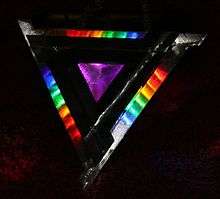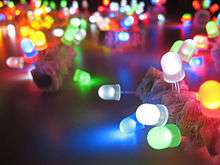LED art

LED Art is a form of light art constructed from light-emitting diodes. Many artists that use LEDs are guerrilla artists, incorporating LEDs to produce temporary pieces in public places. LEDs are very inexpensive to purchase and have become a new way to make street art. LEDs are, among others, used in installation art, sculptural pieces and interactive artworks.
Infamous LED Art
In early 2007, there was a bomb scare in Boston, Massachusetts in the United States caused by a guerrilla marketing campaign. An advertising firm working for Turner Broadcasting System Inc. to promote Aqua Teen Hunger Force, one of the network's animated television shows, hired two artists to produce art for the ad campaign. The artists placed LED signs featuring a character known as a Mooninite in various locations across 10 cities. However, Boston was the only city that reacted by shutting down bridges and bringing in bomb squads to remove the LEDs. The majority of the light boards were removed and the artists were arrested.[1][2]
Artists incorporating LEDs
- Jenny Holzer - One of the most well known artists who incorporates LEDs into her work. She uses familiar statements and reinterprets them to alter their meanings.[3]
- Meeli Kõiva (aka Mery Crystal Ra) - an artist who achieved acknowledgement for her installation "Reactive River" (European Parliament main building, Brussels, Belgium).
- Cell Phone Disco by Informationlab (Ursula Lavrenčič and Auke Touwslager) is an installation that uses the electromagnetic spectrum emitted by the viewer’s cell phone and creates a visual interpretation. The LEDs are attached to large grids and when a phone is activated in a section of the room, the lights turn on.[4]
- GreenPix – Zero Energy Media Wall – created as an environmentally friendly art space. It acts as a low resolution screen for artists to show their work.[5]
- Liu Dao- an art collective in China that uses actors and filmmakers to make animated LED portraits. The group also combines traditional Chinese arts like papercutting with LEDs to highlight China's journey from tradition and modernity, and is directed by Thomas Charvériat to find originality through international collaboration.[6]
- Titia Ex - an artist from Amsterdam who achieved acknowledgement for her installation 'Flower of the Universe'.[7]
- Leo Villareal - his work combines LED lights and encoded computer programming to create illuminated displays.[8]
- Jim Campbell - LED artist based in San Francisco.
- Al Linke led a collaborative LED art project called PIXEL. Pixel artists all over the world contributed 32×32 and 64×64 pixel art, mainly in the form of animated gifs which are displayed on the PIXEL LED Display.
LED throwies

An LED throwie is a small LED attached to a coin battery and a rare earth magnet (usually with conductive epoxy or electrical tape), used for the purpose of creating non-destructive graffiti and light displays. Artists use them by throwing individual LEDs onto metallic objects, like public sculpture or road infrastructure. By throwing LEDs onto an object, the object itself acts as a canvas. LED throwies were invented in 2006 by the artists Evan Roth and James Powderly the founder of Graffiti Research Lab[9] at Eyebeam Atelier open lab NYC. After Graffiti Research Lab posted the instructions how to make a throwie on Instructables,[9] LED throwies went viral on the Internet and could be found in advertising, were for sale as DIY kits or further developed by other artists and hackers worldwide.
Blinkies

Blinkies are small electronic devices that make very bright light (usually flashing) using LEDs and small batteries. They are often sold by vendors at night-time events that have fireworks displays such as Independence Day, Canada Day, or Guy Fawkes Night. They are also popular at raves, New Year's Eve parties and night time sporting events.
There is no industry standard or official name for blinkies, but most common names use some combination of the terms flash, magnet, strobe, body, blink, light, and/or jewelry. Common examples are blinkies, blinkees, body lights, blinky body lights, magnetic flashers, or flashing jewelry.
Uses
Most often blinkies are used for amusement at raves, parties and night time events. But they can have other uses as well such as:
- Blinkies imprinted with company logos at conventions.
- Safety lights for children during Halloween, or night time events.
- Fun and safety during camping trips.
- Emergency flashers for disabled automobiles or lost hikers (most blinkies have over a 1-mile visibility range at night).
- The term blinky is often used for bicycle lights which flash. In some countries, blinkies can be used as a primary light on a bicycle.
- Blinkies also can be attached to mobiles (cell phones). When the mobile turns on, make a call, receive a call and during calls the blinky will keep flashing.
- "Winky blinkies" can refer to stage and film props which display lighting effects, or "gags," during a dramatic production.[10]
Construction
Body
A typical blinky is a small metal two piece cylinder wide enough to accept a button cell battery with a very small etched circuit board on the face and threads on the open end, paired with a cylinder cap which screws on to seal and secure as one. The flashing LED circuit board face can be round and enclosed by cylinder, or a variety larger colored shapes such as logos that are glued to the outside face of the cylinder end. Common designs utilize a rubber ring gasket as an on/off switch - when placed between the batteries and circuit board inside the front cover, tightening the screw base deforms and flattens the gasket forcing the battery tip to contact the back of the printed circuit board which completes the circuit.
Back
The most common designs use a set of strong magnets, one at the back of the Body Light, and another that can be removed. This allows the body light to be easily attached to clothes, or stuck on any magnetic metal such as buttons or belt buckles. Clips are often used to make earrings, a loop can make a pendant, or a ring can be welded to the back to make a finger ring. Double sided adhesive pads are sometimes used to stick the blinky directly to the body, most often in the navel.
Circuit board
The circuit board typically has anywhere from 2 to as many as 25 micro-LEDs. LEDs that emit different colors within the visible spectrum are commonly used, whereas ultraviolet or infrared LEDs are less common in Blinkies. Blue, white, violet, and ultra-violet LEDs often require 2 or more battery cells, due to their higher voltage requirements. The visible side of the etched circuit board can be constructed to flash in a variety of ways, especially where there are multiple LEDs in multiple colours. A clear plastic conformal coating material such as silicone, acrylic or epoxy protects the fragile LEDs on the exposed front of the board. Shaped boards have literally hundreds of variations combined with imprinting. Common shapes (besides the classic small circle) are stars, hearts, flowers, flags, animals, holiday symbols (like Halloween jack-o-lanterns), and sports team logos.
See also
- LED (Light Emitting Diode)
References
- ↑ "Two held after ad campaign triggers Boston bomb scare - CNN.com". CNN.
- ↑ "Boston bomb scare - Cartoon Network devices - Turner ad campaign - Boston Globe". The Boston Globe. 2007-07-09.
- ↑ "Jenny Holzer | Art21". PBS. Retrieved 2012-10-06.
- ↑ "Cell Phone Disco". Cell Phone Disco. Retrieved 2012-10-06.
- ↑ McDermott, Mat (2008-06-26). "Big Solar LED Art in China: Interview with Simone Giostra, GreenPix Media Wall Architect". TreeHugger. Retrieved 2012-10-06.
- ↑ "The fantastic light at Louis Vuitton". The China Post. 2010-04-07. Retrieved 2012-10-06.
- ↑ mondo*arc - International magazine for architectural, detail and commercial lighting. "Flower of the Universe". Retrieved 2013-01-15.
- ↑ Tan, Lumi. Biesenbach, Klaus, ed. Greater New York, P.S. 1 Contemporary Art Center, 2005, p338.
- 1 2 Graffiti Research Lab. "LED Throwies". Retrieved 2013-01-15.
- ↑ Thomas Vaccina. "Richard A. Coyle Interview". RACprops Issue 7. RACprops.com. Retrieved 2009-11-02.
External links
- LED Throwies Tutorial on making LED Throwies
- LED Throwies blog European blog about LED Throwies
- A tutorial on how to make more advanced LED graffiti: LED tags and figures using perspex and other light leading materials
- Graffiti Research Lab